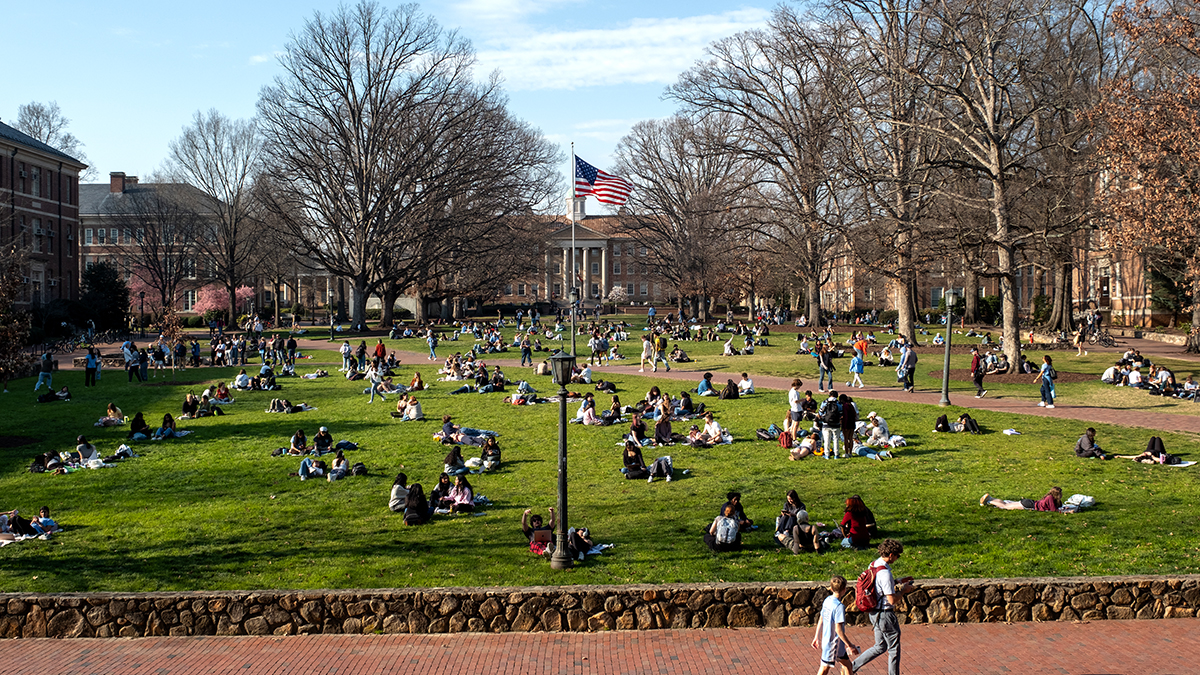Growing Carolina
From lettuce and kale to parsley and basil, edible plants sit waiting to be picked on the Carolina campus. Now they will be under the North Carolina Botanical Garden’s Edible Campus Initiative.
Carolina’s campus is known for its towering oaks and stunning azaleas, but some people are beginning to discover that there are also fresh herbs and vegetables quietly growing in several of Carolina’s small gardens. From lettuce and kale to parsley and basil, edible plants sit waiting to be picked. The North Carolina Botanical Garden’s Edible Campus Initiative (ECI) is a project that promotes edible and sustainable landscaping and maintains a network of edible garden beds throughout the Carolina campus.
Under the leadership of Chancellor Carol L. Folt and with overwhelming support from grounds services and energy services, ECI successfully completed its pilot year and is now entering its next phase with newly appointed Edible Campus Coordinator Laura Mindlin at the helm. Mindlin, a recent graduate of Skidmore College in Saratoga Springs, New York, has been involved in food systems and land management efforts throughout her academic and post-graduate career. Mindlin helped facilitate local food partnerships with the Skidmore College dining hall, co-managed Skidmore’s 160-acre woodland, conducted research on the loss of biodiversity in agriculture and the effects of globalization and studied best agricultural practices throughout Central and South America.
Mindlin’s experiences with diverse food efforts in school made working with Carolina an easy decision. “My involvement within food systems efforts have spanned the gamut—there are so many areas of this work that excite me and need our attention,” said Mindlin, who began her job at Carolina in November. “I wanted to continue working at the university setting, as the college years are a vital time for individuals to establish a positive relationship with nature and the foods that nourish them.”
In addition to allowing people to freely harvest leafy lunch garnishes, Edible Campus encourages students to interact with their campus landscapes to better understand their roles in the food system.
Davis Library already hosts an Edible Campus pilot plot and will soon be the site of a demonstration garden that will serve as ECI’s central garden for its various events and programs.
“The gardens serve as a space for passersby to be reminded where their food comes from and to see an alternative approach to landscape design that preserves the natural ecosystem,” Mindlin said.
Edible Campus has its roots in an independent study project undertaken by Emily Auerbach in the spring of 2015. The project, which included a proposal for a comprehensive edible landscaping program, was presented to Folt in April 2015. Having previously expressed an interest in expanding Carolina’s commitment to working landscapes, Folt made Auerbach a Chancellor’s Fellow to pursue the program for one year. ECI has since developed into fully formed program boasting nine satellite sites around campus. Construction has also started on a demonstration garden located behind Davis Library that will serve as ECI’s central garden for its various events and programs.
Edible Campus is now managed as part of the North Carolina Botanical Garden, which is striving to keep the initiative “dynamic and engaging,” said Nancy Easterling, the garden’s director of education. She said the project’s purpose is “making a difference in the lives of the university community and the students on campus by providing opportunities for a much better understanding of food security, food systems, sustainable landscapes and how they all fit together.”
Mindlin, who will manage the operations of both the demonstration garden and satellite gardens around campus, has many plans for ECI, including educational programming, an important driver of future growth.
“I am going to let students take charge,” Mindlin said. “This means having clubs host workshops in the garden, service learning students help design the satellite beds, and student management of our demonstration garden.”
Launched in 2015, the Edible Campus Initiative has grown to nine satellite gardens in the heart of campus. A full map including plant types can be found at http://arcg.is/2holwLR.
Professor Amy Cooke has incorporated the Edible Campus into her environment and ecology class. Through an APPLES Service Learning component, her students help maintain the gardens. The course helps students form an appreciation for food and where it comes from, said Tony Mayer, the doctoral student and teaching assistant who oversees their work. “Students just really love growing things from seeds,” he said.
Mindlin said she envisions professors from all different disciplines using the gardens to create educational exhibits showcasing scientific, agricultural, cultural or historical research. Themed gardens — from medicinal herbs to historically accurate examples of African American agriculture — offer a way to give diversity to each satellite site.
“I’ve already had several club leaders looking to partner, faculty members wanting to use our sites for their research and students eager to get their hands dirty and plant some crops,” Mindlin said. “The support is there.”
Mindlin is focused on how to best use the current gardens, but also plans to increase these working landscapes on Carolina’s campus.
“In the long term, we hope to add more edible and working landscapes to campus, and heighten the visibility of those already there. UNC Facilities and Grounds Services have been committed to this work even before Edible Campus Initiative, so there is great potential for the future,” Mindlin said. “But short term, our focus is on using our garden beds efficiently and figuring out what works for students, what really draws people in and what kind of space is needed for faculty to incorporate our garden spaces into their coursework.”
Whether it be picking some fresh spinach for a salad or planting an educational garden for hands-on learning, ECI provides a concrete way for Carolina students, faculty and staff to come together and connect with food in a sustainable way.




